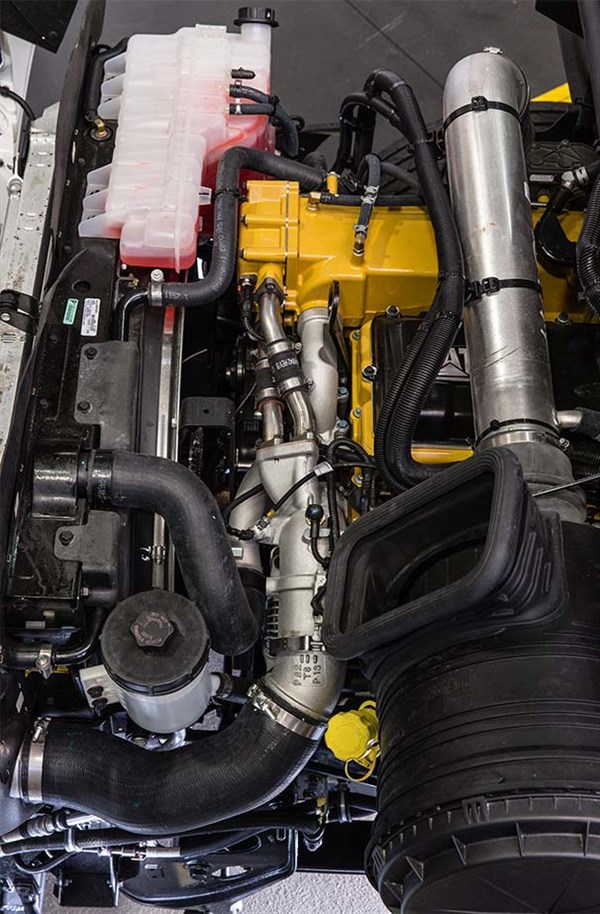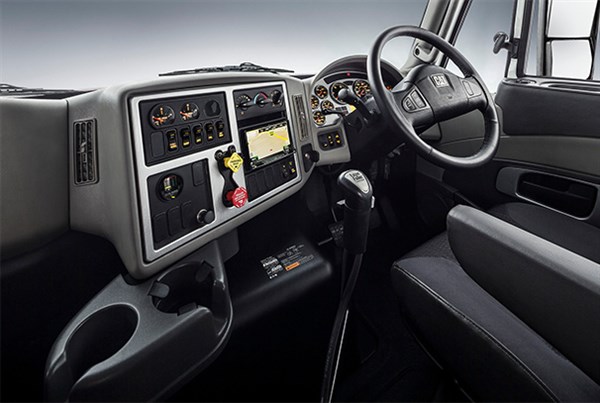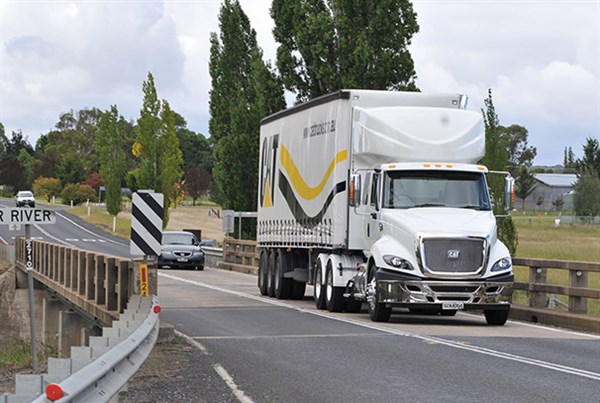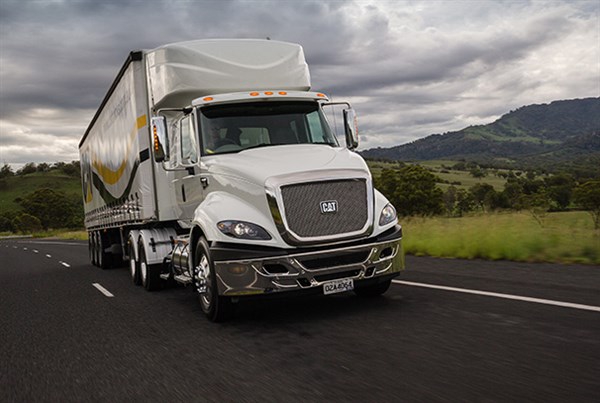Join Matt Wood as he tests out the CAT CT610, a standout model from this year’s Brisbane Truck Show.
It may come as no surprise that the new ADR 80/03 emissions-compliant 13-litre engine from Cat, the CT13, has some European heritage. ADR 80/03 or Euro 5 found the emissions limitations of the old Caterpillar C13 leaving Cat’s CT610 model looking for a new, clean burning powerplant.
Along the way, the CT610 has dropped its old Navistar PayStar platform and picked up the same ProStar platform as its big brother, the CT630; but underneath the bonnet there was a hole that needed to be filled.
Engine
The solution came via Navistar’s MaxxForce 13, a cooled exhaust gas recirculation (EGR) engine that came to Navistar from European heavyweight MAN.
Now yellow and wearing some Cat badges, the 354kW (475hp), 2,305Nm (1,700ft-lb) of torque CT13 has taken over from the C13 as the engine of choice for the single trailer/tipper local and long-haul spec CT610.
Transmission
The CT610 is available with an 18-speed Eaton Roadranger manual transmission or an UltraShift Plus AMT with Hill Start Assist.
Cab and Controls
The bumper-to-back-of-cab (BBC) comes in at 2,885mm while the extended cab option provides a 660mm (26-inch) bunk with slide out storage.
Outwardly the CT610 doesn’t appear to have changed much, but a quick look at its predecessor shows that the baby of the Cat range now looks that little bit more grown up, sharing the same face of its big brothers in the 630 range.
As a consequence, the CT610 has lost its rather squinty-eyed look with LED headlights now standard equipment.
A nice surprise was that the Cat is one of the few trucks on the market that doesn’t reflect the instrument panel lights onto the side windows at night. There has to be an upside to the funny looking, yet paradoxically, well laid out dash board.
My biggest criticism still stands, there’s just not enough storage near the driver for things like phones, iPods, pens and paperclips.
I call this casual storage space and in the Cat the only place for things like this is the cup holders, there’s a nice gap between the cup holders and the steering column just under the stereo that is just screaming out for a storage tray, although this gap will not exist on automated manual transmission (AMT) equipped models.
Performance
I recently had the chance to check out the Cat CT610 when I drove the new Cat CT610 from Brisbane to Melbourne via the New England and Newell highways.
This was a chance to see whether the new powerplant could live up to the formidable legacy left by the old 13-litre engine. One question hung in my mind though: could it really be called a Cat engine?
The CT610 is aimed mainly at local, intra and interstate single-trailer applications, and of course construction and mining with a GCM of 63.5 tonnes as a prime mover.
Without a doubt, the single most striking thing about driving the new truck is noise or, to be more precise, the lack of it.
The CT13 uses a compacted graphite iron (CGI) engine block. While this makes it both very strong and very light (some 220kg lighter than the C13) the lack of resonance from the CGI material also makes it very quiet; Cat claims it’s about 30 percent quieter than the earlier C13.
In-cab noise levels, in my opinion, would be on a par with those of a gas fuelled engine, and perhaps another contributing factor maybe the multi-shot fuel injection cycle of the engine.
As with many heavy-duty diesel engines the CT13 uses high pressure common rail injection (some 2,200 bar or 32,000psi of pressure). But at the injector end, the CT13 injects fuel into the combustion chamber in short multiple doses.
This is meant to prolong the combustion cycle and increase the cleanliness of the fuel burn. This is also something quite important in an engine that is recycling 20 percent of its exhaust gasses at the same time.
Cat also claims this process makes significant inroads with in fuel economy as well.
On the road, this all translates into a truck with a muted, yet present, engine note that is actually doing a lot more than it sounds like and it does keep you glancing at the tacho until you get used to it.
After leaving Brisbane, the first real test of the new engine was, appropriately enough, Cunningham’s Gap. I was actually pretty keen to leave Aratula after making a goose of myself for trying to order a ‘long macchiato’; the stony, scornful stare said it all.
But at a gross weight of 42-tonne, I kept the go pedal to the floor to tackle the climb.
After Aratula I didn’t think my ego could recover from the humiliation of missing a gear while climbing ‘The Gap’. Climb the little 13-litre did.
With a sweet spot (and peak horsepower) at around 1,700rpm, the yellowmotor hung on gamely making the whole climb without needing to leave top ‘box in the 18-speed Roadranger transmission.
Yes, the coolant temp did climb as you’d expect and the engine fan was roaring for at least the last half of the climb. But all the same, I felt the Cat made a very respectable effort.
The Pacific Highway had just reopened after flooding, so the New England Highway road surface had just been hammered with more than twice the traffic load than it was used to.
The New England was now trashed, a bumping, bucking goat track of split, cracked and shattered asphalt. What better way to test out the road manners of the CT610?
The prime mover and trailer were bounced all over the shop, yet the Cat remained predictable and easy to handle, the National air-suspended seat soaked up the bangs and thumps reasonably well, but the pillar mounted seat belt anchor made life pretty damn uncomfortable.
At times I felt like an orang-utan trapped in the coils of a giant anaconda as the belt tightened around me on the bouncing seat. Go for the Gramag seat option, it has an integrated belt.
As with the rest of the Cat truck range, the standard final drive ratio is a relatively tall 3.91:1. This is a great highway ratio for fuel economy as it effectively turns the 18-speed Eaton transmission into a double overdrive.
But, as a general rule, you need to have the grunt to back it up. Otherwise you just spend a lot of time changing gears. Luckily the CT13 seems to have enough torque in the right places to cash the cheques that the driveline is writing.
With peak torque available from 1,000rpm the engine seems almost schizophrenic in nature, low-down and torquey on one hand, yet quite peaky and rev happy on the other.
The dual sequential turbo’s spool-up power smoothly but without the high pitched whine of old. But the taller rear end ratio means that the CT610 needs to be driven, especially on a road like the New England. As soon as the road starts to climb, you need to be out of overdrive very quickly; in fact, for many stretches, I just didn’t use it.
If I was working solely around town or in and out of quarries and building sites, I’d be looking at the 4.10:1 ratio option. However, if you adopt a rather proactive approach to the gear stick, you’ll be rewarded with quite a gutsy little engine that leaps at hills with all of the enthusiasm of a Cypriot heading to the bank.
The engine brake, on the other hand, does take some getting used to. The Jacobs-branded engine brake is startlingly quiet, and sounds like an exhaust brake initially, but to make the most of the retardation on offer the tacho needle needs to be hovering above 1,700rpm and doesn’t crank out peak braking horsepower until 1,900rpm.
Again this means that you need to be out of overdrive if you want to bleed some speed on a long slope. On a descent like the Moombie’s, just north of Tamworth, the engine brake was really put to the test, and with the engine roaring at 2,000rpm, the Jake brake worked wonderfully and very quietly.
This is the sort of engine brake that doesn’t attract any attention when rolling through country towns in the middle of the night, which may disappoint some of the more antisocial types out there.
The first thing that really grabs you when you flip the bonnet of the 610 is the massive EGR cooler that runs the length of the engine block. This engine was originally designed to satisfy the current United States EPA10 emissions regime — Australia is still at the equivalent of EPA07.
As a result of the higher running temperatures of EGR, the engine has two separate water jackets designed to maintain a consistent temperature across the whole engine and eliminate hot spots.
This is an engine that was designed to keep its cool with a 50 percent exhaust recirculation flow rate, in Australia it will only recirculate around 20 percent. As with most EGR engines the CT13 uses active regeneration to clear the single diesel particulate filter (DPF) that hangs under the chassis.
Once south of Dubbo out on the open plains, the CT chugged along quietly and happily and it was an almost relaxing drive.
When the sun descended below the horizon just past Narrandera I flicked the lights on, I’ve said it before and I’ll say it again; I love LED headlights. The almost bluish white of the beam picks out everything without assaulting your eyeballs over long periods of time.
I pulled up for the night near Shepparton and bunked down in the 26-inch sleeper.
I have to say that I actually slept quite well, and while a bit cosy for full-time living away from home it would still serve as a reasonable place to camp when needed — that still didn’t stop me from whacking my head on the roof when I woke up in the morning.
Verdict
I’m going to do something rather questionable and compare this engine to another on the market, one that is sold in a different part of the market, yet will butt heads with the CT610 on occasion — the Mack MP8.
Sure the 13-litre Mack engine puts out 60 more horsepower and marginally more torque than the CT13 and the MP8 uses selective catalytic reduction (SCR) rather than EGR. But they do have a couple of things in common; European heritage and a low, flat torque curve and both engines have that feeling that they are punching above their weight.
However, from behind the wheel, the MP8 does what it’s told, whereas the CT13 talks back, it engages you in the process. The Cat feels harder edged and in manual guise more driveable than the MP8, if Cat had a set forward steer axle option for the CT610 it would be a walk up start for 19m B-double and quad dog tipper applications.
Should the CT13 be called a ‘real’ Cat engine? Well, it does have many of the characteristics of the yellow engines of old from C12 to C13 from driveability to ‘luggability’ (I think I just made a word up).
However, there is a smoother more civilised side to the engine, one that does point to an outside influence. It almost feels as if Cat sent a disassembled C13 to Europe and asked someone to put it back together again.
Regardless of the badge, the CT610 remains an engaging drive, but with a sensitive side.
Specifications
Make/Model: Cat CT610
Engine: 13-litre Cat CT13 with cooled EGR and active DPF regeneration
Emissions: ADR 80/03 (Euro 5)
Power/Torque: 475HP (354KW) @ 1,700RPM / 1,700FT-LB (2,305NM) @ 1,000RPM
Transmission: 18-speed Eaton Roadranger manual, UltraShift Plus AMT with Hill Start Assist optional
Final Drive: Meritor RT 46-160, ratio 3.91:1 (4.10:1 and 4.30:1 optional)
GCM: Truck and Trailer applications: 58,000kg
GCM: Prime mover applications: 63,500kg












